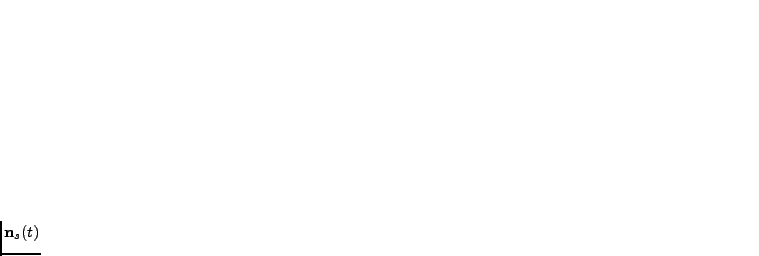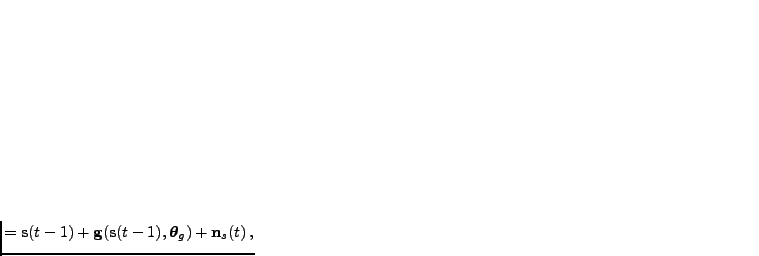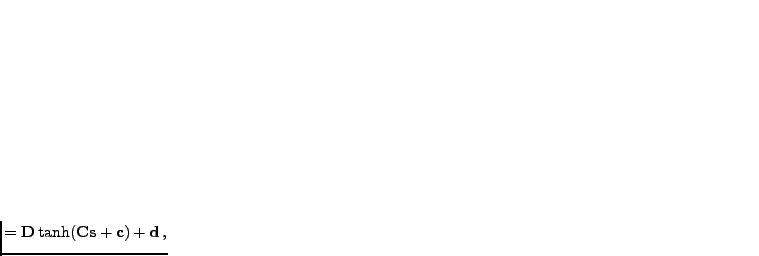



Next: State inference
Up: Variational learning of nonlinear
Previous: Nonlinear factor analysis
Contents
Nonlinear state-space models
In many cases, measurements originate from a dynamical system and form
time series. In such cases, it is often useful to model the dynamics
in addition to the instantaneous observations. Valpola and Karhunen (2002)
extend the nonlinear factor analysis model by adding a nonlinear
model for the dynamics of the sources
 . This results in a
state-space model where the sources can be interpreted as the internal
state of the underlying generative process. On the other hand,
nonlinear state-space models are a direct extension of linear
state-space models (see Section 3.1.6) where the linearity
assumption is relaxed.
. This results in a
state-space model where the sources can be interpreted as the internal
state of the underlying generative process. On the other hand,
nonlinear state-space models are a direct extension of linear
state-space models (see Section 3.1.6) where the linearity
assumption is relaxed.
The nonlinear static model of Equation (4.6) is
extended by adding another nonlinear mapping
 to
model the dynamics. This leads to source model
to
model the dynamics. This leads to source model
where
 are the sources (states),
are the sources (states),
 is the
Gaussian noise, and the dynamics mapping
is the
Gaussian noise, and the dynamics mapping
 is modelled
by an MLP network.
is modelled
by an MLP network.
In case the dynamic system is changing slowly, there are high
correlations between consecutive states. This is taken into account by
giving up the fully factorial posterior approximation used in
nonlinear FA. The posterior distribution of each component  of the
state vector
of the
state vector
 is conditioned on the same component
is conditioned on the same component  of the
state vector
of the
state vector
 . The approximate density
. The approximate density
 is parameterised by the mean, linear dependence, and
variance (see Valpola and Karhunen, 2002, for details).
is parameterised by the mean, linear dependence, and
variance (see Valpola and Karhunen, 2002, for details).
Considering the sequence of consecutive mappings
 in the system
dynamics, where each mapping
in the system
dynamics, where each mapping
 consists of a linear mapping,
component-wise nonlinearities, and a second linear mapping, one might
think that one of the two linear mappings before and after the states
is redundant since two consecutive linear mappings can always be combined
into one. The second mapping allows the model to select a
representation where the variational approximation is most
accurate. It also allows the dimensionality of the state-space to be
different from the number of used nonlinearities, thus decreasing
computational complexity in some cases.
consists of a linear mapping,
component-wise nonlinearities, and a second linear mapping, one might
think that one of the two linear mappings before and after the states
is redundant since two consecutive linear mappings can always be combined
into one. The second mapping allows the model to select a
representation where the variational approximation is most
accurate. It also allows the dimensionality of the state-space to be
different from the number of used nonlinearities, thus decreasing
computational complexity in some cases.
An important advantage of the VB method is its ability to learn
a high-dimensional latent source space.
Computational and over-fitting problems have been major
obstacles in developing this kind of unsupervised methods thus far.
Potential applications for the method include prediction and process
monitoring, control, and speech enhancement for recognition.
Is process monitoring, Ilin et al. (2004) show that VB learning is
able to find a model which is capable of detecting an abrupt change
in the underlying dynamics of a fairly complex nonlinear process.
Subsections




Next: State inference
Up: Variational learning of nonlinear
Previous: Nonlinear factor analysis
Contents
Tapani Raiko
2006-11-21
 . This results in a
state-space model where the sources can be interpreted as the internal
state of the underlying generative process. On the other hand,
nonlinear state-space models are a direct extension of linear
state-space models (see Section 3.1.6) where the linearity
assumption is relaxed.
. This results in a
state-space model where the sources can be interpreted as the internal
state of the underlying generative process. On the other hand,
nonlinear state-space models are a direct extension of linear
state-space models (see Section 3.1.6) where the linearity
assumption is relaxed.
 to
model the dynamics. This leads to source model
to
model the dynamics. This leads to source model




 is the
Gaussian noise, and the dynamics mapping
is the
Gaussian noise, and the dynamics mapping
 is modelled
by an MLP network.
is modelled
by an MLP network.
 of the
state vector
of the
state vector
 is conditioned on the same component
is conditioned on the same component  . The approximate density
. The approximate density
 is parameterised by the mean, linear dependence, and
variance (see
is parameterised by the mean, linear dependence, and
variance (see